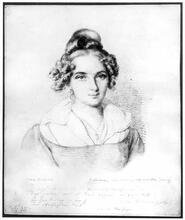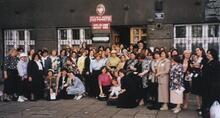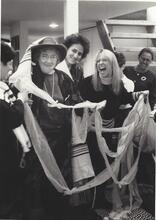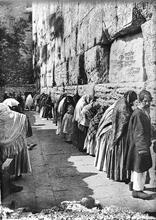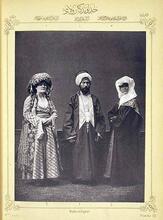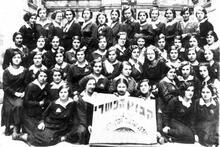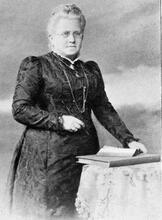Hasidism
Hasidism—a spiritual revival movement associated with the founding figure of Israel Ba’al Shem Tov—has sometimes been depicted as nothing less than a “feminist” revolution in early modern Judaism. Samuel Abba Horodezky, for example, argued that the connection between the Rebbe and the community created an equalizing force between husband and wife, that Hasidism made scholarship more accessible to women, and that it allowed them to be promoted to authoritative positions. Far from pioneering the equality of men and women in Judaism, however, the Hasidic movement of the eighteenth and nineteenth centuries conceptualized gender in conventional terms drawn unquestioningly from the classical rabbinic, philosophical, and kabbalistic sources. It construed women as permanently anchored in the domain of worldly existence, marked by their intrinsic materiality, corporeality, and potentially dangerous sexuality.
A Feminist Revolution in Early Modern Judaism?
Hasidism—a spiritual revival movement associated with the founding figure of Israel Ba’al Shem Tov (Besht, c. 1700–1760), which began in Poland in the second half of the eighteenth-century and became a mass movement of Eastern European Jewry by the early decades of the nineteenth—has been celebrated as nothing less than a “feminist” revolution in early modern Judaism. The first to depict it in this light was Samuel Abba Horodezky (1871–1957) who, in his four-volume Hebrew history of Hasidism, first published in 1923, claimed that “the Jewish woman was given complete equality in the emotional, mystical, religious life of Beshtian Hasidism” (vol. 4, 68). Horodezky’s account underlies virtually every subsequent treatment of the subject, whether in the popular, belletristic, and semi-scholarly literature on the history of Hasidism, or in such works, mostly apologetic and uncritical, as have set out to discover and catalogue the achievements of prominent women throughout pre-modern Judaism. Notably, until relatively recently, Hasidic scholarship has totally ignored the subject, implicitly dismissing it as either marginal or insufficiently documented to permit serious consideration.
Horodezky contrasted the equality he perceived between men and women in Hasidism with the exclusion of women from the intellectual and devotional life of what he termed “official Judaism” or “rabbinism.” Classifying the latter as intrinsically “rational” while defining Hasidism (together with mysticism and messianism) as “emotional”—faculties which he assumed as a matter of course to be inherent in the male and female natures respectively—he was able to argue that unlike “rabbinism,” which catered primarily for men, Hasidism was “naturally” both accessible and hospitable specifically to women. This was expressed in three ways:
1. Hasidism, which revolved round the intimate connection between a charismatic leader (titled Zaddik or Rebbe) and the community of his adherents, forged a strong new bond between husband and wife through their common allegiance to their Rebbe. This acted as an equalizing force between the sexes, invigorating family life and raising the status of women in the community.
2. Hasidism threw open the gates of scholarship to women by producing, in addition to works in Hebrew—traditionally accessible only to educated men—also a large body of literature in the vernacular, Yiddish, which was accessible to women. As a result, the largest obstacle was removed from the way to the full spiritual and intellectual development of women within Hasidism.
3. Hasidism promoted some women to the highest positions of spiritual leadership, enabling them to function as female Rebbes on a par with their male colleagues: “If the woman was worthy, nothing could stand in her way” (vol. 4, 69).
These extravagant claims stand in sharp contrast to Horodezky’s own initial account of the same subject, which he published some fourteen years earlier, in 1909, in the Russian Jewish periodical Evreiskaya Starina. His information, as he explained, was based entirely on oral traditions heard from “old women in Volhynia,” and he introduced it as follows:
In Hasidism a modest, passive role is attached to a woman. From time to time, she may approach a Zaddik, pour out her soul before him and receive counsel and a blessing from him. Very rarely in the history of Hasidism do we encounter active female characters who have influenced their surroundings. (1:2, 219)
While the 1909 version was published not long after Horodezky’s move to the West from his native Ukraine, the later adaptation appears to have sprung from his subsequent exposure to German-Jewish feminism and his growing involvement with the Zionist movement, during his years of academic education and intellectual work in Zurich, Berne, and Berlin. It was during this period that the second and third Lit. "ascent." A "calling up" to the Torah during its reading in the synagogue.aliyot (1904–1923) were experimenting with the foundation of a revolutionary society in the Holy Land, where the women were to play, in theory if not in practice, an equal part alongside the men. All this must have heightened Horodezky’s sensitivity to the issue of the equality of women, which he now believed to have been fully anticipated in the “egalitarian” character of Hasidism. This was in line with his overall view of the Hasidic spiritual revival as an authentically Jewish model for the rebirth of the Jewish nation on its historic land, cleansed of all the Lit. (Greek) "dispersion." The Jewish community, and its areas of residence, outside Erez Israel.Diaspora maladies of “rabbinism.”
Every one of Horodezky’s claims may be qualified, countered or quite plainly
1. Bond of Marriage Claim
Far from improving the position of women and reinforcing the bond of marriage through the equality of husband and wife before the Rebbe, Hasidism seems to have effected precisely the opposite. Both the rabbinic opponents of the movement, the mitnaggedim, and the Enlightened modernizers, the female/sing.: Member of the Haskalah movement.maskilim, accused Hasidism, with apparent justification, of undermining the institution of marriage and aggravating the condition of women by drawing young men in their early years of marriage—the main recruits to the movement in its formative years—away from their wives and children for periods ranging from several weeks to several months and more. They abandoned the women to fend for themselves materially and, even more crucially, absented themselves at precisely those points in the Jewish calendar—the Sabbath and Festivals, the most popular times of assembly at the court of the Hasidic leader—at which the presence of the husband and father was essential for proper ritual celebration at home. In fact, as an emotionally charged and exclusively male fraternity, grouped around the figure of the Rebbe as “father,” speaking of “love” as the mutual relationship among themselves and between the Rebbe and his “children,” celebrating the highest moments of communal activity at a “table,” during a “meal,” and on the occasions traditionally set aside for domestic worship and festivity, Hasidism provided an effective alternative to traditional family life. It did not, of course, renounce marriage formally or on a permanent basis, but it offered its male followers periodic liberation from marital and family ties, for the sake of the higher pursuit of spiritual invigoration. In the initial stages of Hasidism, the attachment of young recruits to this alternative, woman-free, spiritual family often entailed a partial or even a complete break with their non-Hasidic or anti-Hasidic biological families. This diminished in time, as the affiliation with Hasidism ceased to be a voluntary act by individual males and became more commonly inherited, encompassing whole families that now transmitted the association with one Hasidic leader or another from generation to generation.
Whether or not at this stage, from the early decades of the nineteenth century, the position of women who had inherited their Hasidic identity was significantly different from that of their non-Hasidic counterparts is extremely difficult to assess. Generally, however, they continued to be excluded from the life of the Hasidic court. They did not usually accompany their men on their visits to the Rebbe, and descriptions of male Hasidim of all ages setting out on their Festival journeys to the courts of the Zaddikim while leaving their womenfolk behind persist until well into the twentieth century. Some Hasidic leaders, notably several generations in the Habad-Lubavitch line, explicitly forbade the admittance of women to their courts, and the mid-nineteenth century Isaac of Nezkizh (Nesukhoyezhe, Ukraine) (1789/90–1868) is said to have severely restricted the terms on which he would see women, apparently as a strategy, adopted towards the end of his life, designed to reduce the number of his visitors, which by that time had exceeded the capacity of the court to sustain them. The accessibility of the courts to women was probably subject to regional differences and a variety of policies and idiosyncratic practices adopted by individual Zaddikim. Nevertheless, the hagiographical literature of Hasidism suggests that, at least in some cases, women could gain access to the Rebbe in their own right, to be advised and blessed by him as were his male followers. This is corroborated by the internally contradictory claims made by some of the mitnaggedim who, while accusing the Hasidim repeatedly of deserting their women and children to linger idly at the courts of the Zaddikim, refer also to women who flock to the courts and whose presence there, to seek advice or a blessing, inevitably leads to all manner of licentious conduct among the Hasidim. It is, however, clear from all the available evidence that, even if they were granted a private audience with the Rebbe, the women were never admitted to the all-important sessions at his “table,” where he would deliver his Hasidic teaching to an exclusively male audience.
2. Accessible Scholarship Claim
Hasidism did produce a considerable body of literature in Yiddish, but this was by no means created especially for women, nor did it represent any attempt to make universally accessible in Yiddish all the works that had been previously restricted to the Hebrew-reading male elite. The translation of Hasidic books from Hebrew into Yiddish began relatively late in the development of the movement, with the publication of the Yiddish version of Shivhei ha-Besht (In Praise of the Besht) in 1815. This appeared in several editions and versions only a few months after the launch of the first Hebrew edition in December 1814. Significantly, as well as being the first Hasidic book to become available in Yiddish, Shivhei ha-Besht, consisting of cycles of tales celebrating the saintly lives and extraordinary feats of the Besht and his associates, was also the first Hasidic book to belong to the hagiographical genre. This was a literary genre which the Hasidic movement never invested with the full legitimacy and authority it accorded its speculative-homiletical literature, whose publication had begun much earlier, in the 1780s and 1790s. Moreover, following the appearance of Shivhei ha-Besht in both Hebrew and Yiddish, the publication of Hasidic hagiography was arrested for at least another fifty years, quite possibly on account of the uncertain status of the genre, which had attracted the critical attention and ridicule of the maskilim.
Publication in this genre was eventually resumed, with a fresh crop of works achieving popularity, if not full sanction, in the second half of the nineteenth century. The hagiographical works that proliferated from then on, whether they were published in Hebrew, in Yiddish, or in both, were not directed primarily at women, although women may well have formed a significant proportion of their readership. The point, however, is that Hasidism did not possess any ideology of women’s education as such (at least, not until the twentieth century, and for extraneous reasons). What it did possess was an internally controversial but nonetheless pervasive ideology of communication: the teachings and ethos of Hasidism were disseminated purposefully and widely, albeit on a variety of levels, in different modes, and with varying degrees of exposure to its radical or esoteric doctrines, as was felt to be appropriate for different classes of recruits.
The transmission or consumption of hagiographical tales in Hebrew and even more so in Yiddish served as the lowest point of access into the Hasidic orbit, however much it was promoted from the start as a meritorious activity of the highest degree of holiness. The tales captured the imagination even of ordinary, uneducated Jews, a class within which women had traditionally formed a sub-category. It was only in this incidental capacity that they became a target audience for the hagiographical literature of Hasidism. While they may have constituted an element of the readership of Shivhei ha-Besht when it was first published at the beginning of the nineteenth century, they very likely represented a substantial segment of it by the 1860s and 1870s, when the second wave of Hasidic hagiography was beginning to flood the book market. By that time Hasidism had become an affiliation into which one was born, within which one married, and which one passed on to one’s offspring, both male and female. Although the women were no more directly involved in the devotional life of the court at this stage than they had been in the earlier period, their Hasidic identity had become firmly established, and it could be nourished by the hagiographical literature that was available to them.
However, alongside this popular literature in the vernacular, Hasidism continued to publish, and to ascribe the highest value to, a large body of speculative writings in Hebrew. Mystical and ethical works of this nature usually originated in the sermons or discourses that were delivered orally by the Hasidic masters to the gatherings of their male followers at their courts. While the language of delivery was Yiddish, often combined with Hebrew and Aramaic elements drawn from the earlier literary sources, the printed versions, following a publication convention that prevailed long before and outside Hasidism, were always in Hebrew translation. As a result, the speculative teachings of Hasidism were as inaccessible to women in print as they were in their original form of oral delivery in Yiddish. Notably, it was with these speculative teachings, and in Hebrew, that Hasidism first launched itself in print. In the three and a half decades between the publication of the first collection of Hasidic homilies in Hebrew in 1780 and the publication of the first hagiographical work in Yiddish in 1815, at least thirty speculative works by major figures in the early Hasidic leadership were published exclusively in Hebrew. They formed an important element of the campaign for the wider dissemination of Hasidism during the crucial stage of its expansion beyond its region of provenance. It was during this period also that the internal Hasidic controversy erupted about the degree to which it was appropriate to publicize in print the traditionally esoteric, kabbalistic aspects of Hasidism. Significantly, throughout this debate no mention was ever made of women as a distinct class to be initiated into or, conversely, to be excluded from any particular level of instruction. Women might have been implicitly classified as “ignorant” together with uneducated men, but they were never explicitly or directly addressed in the literature of Hasidism.
3. Women in Spiritual Leadership Claim
Horodezky’s final and most dramatic claim, that certain women could attain even the rank of Rebbe, is introduced with a discussion of a number of distinguished women—mothers, sisters and daughters (though, significantly, not wives) of the most famous male leaders of early Hasidism: Adel (Hodel), the daughter of the Besht; her daughter Feige, who was sister to two renowned Hasidic masters—Barukh of Medzhibozh (1757–1810) and Moses Hayyim Ephraim of Sudlikov (1740–1800?), and mother to another—Nahman of Bratslav (1772–1811); Rahel, the daughter of Abraham Joshua Heschel of Apta (Opatow, d. 1825); and Hannah Hayyah, the daughter of Mordecai of Chernobyl (d. 1837) (vol. 4, 69). These women are described as “endowed with divine inspiration,” “famous in the world of Hasidism for […] knowledge of rabbinic legends and tales of the lives of the Zaddikim,” “influential,” “charitable,” or “sought after by many of the Hasidim […] for a blessing.”
Horodezky does not supply any sources from which these descriptions might have been drawn. Some of them may be traced back to well known, fairly early Hasidic works, such as the reference in Shivhei ha-Besht to Adel (Hodel), whose distinguished soul the Besht had derived from the Torah she-bi-khetav: Lit. "the written Torah." The Bible; the Pentateuch; Tanakh (the Pentateuch, Prophets and Hagiographia)Torah itself, as is indicated by the fact that the three letters comprising her name are the acronym of the verse in Deuteronomy 33:2, Esh Dat Lamo (“A fiery law unto them”), or the tradition reported by Nathan Sternharz in Hayyei Moharan, his biography of Nahman of Bratslav, according to which Nahman’s mother, Feige, possessed the gift of prophecy and was able to “see” her grandfather, the [dead] Ba’al Shem Tov, at the wedding of her granddaughter. Others must be based on later oral traditions whose authenticity is difficult to establish. Nevertheless, the fact need not be questioned that these women, and others like them, commanded considerable prestige and authority in Hasidic circles. After all, the Jewish tradition, going as far back as the classical rabbinic sources, had always allowed for some of the glamour associated with its most illustrious male leaders to reflect on the women most intimately connected to them. Such women would be viewed as well placed to distinguish themselves by their piety, humility, and even scholarly and The legal corpus of Jewish laws and observances as prescribed in the Torah and interpreted by rabbinic authorities, beginning with those of the Mishnah and Talmud.halakhic acumen, by virtue of their proximity to the remarkable men to whom they were related. It is not surprising, therefore, that Hasidism, a movement that almost uniquely in the history of Judaism placed the extraordinary personality of the charismatic leader at the very heart of its theology and social organization, should exploit this tradition to the full, and allow the Zaddik’s aura of perfect scholarly, ethical, and spiritual accomplishment, together with the supernatural powers that flow from it, to percolate to some of his female relations.
While Horodezky’s information about the activities of these women is focused on their remarkable virtues, extraordinary spiritual gifts, and informal influence in the Hasidic world within which they were extremely well connected, his interpretation suggests the possibility that they functioned as fully fledged “female Zaddikim.” He even quotes a tradition, without citing its source, whereby the brothers of Hannah Hayyah of Chernobyl—all Zaddikim in their own right and heirs to their famous father, Mordecai of Chernobyl—had said that “she was a Zaddik just like them” (vol. 4, 69), but he supplies no details to illustrate any formal-institutional aspects of her leadership or indeed that of any other woman he mentions in this connection. Such information, however, is provided in abundance by subsequent authors in Yiddish, Hebrew, and more recently also in English and other European languages. Almost without exception, these can be shown to have been inspired by Horodezky, but to be more systematically, and perhaps more apologetically, concerned to produce a full record of prominent women in the history of Judaism, where Hasidism invariably features as an exceptionally dignified chapter. Here we find descriptions of various daughters, mothers, and sisters of the famous Zaddikim (although again, only very few wives, and those usually as widows; it would seem that so long as a woman’s relation to the Zaddik is marital, namely sexual, her powers, however great, are confined within the boundaries of her conventional female role, perceived as being complementary rather than analogous to her husband’s powers). Among these women are all those originally mentioned by Horodezky, but also others, such as Mirosh, daughter of Elimelekh of Lyzhansk (Lezajsk, Poland) (1717–1784); Frieda, daughter of Shneur Zalman of Lyady (1745–1813); Pereleh, daughter of Israel ben Shabbetai Hapstein (1733–1814), the Maggid of Kozienice; Tsizye Hannah, the widow of Israel Abraham of Cherny Ostrov (1772–1814), son of Meshullam Zusya of Annopol (Ukraine, d. 1800); Edl, daughter of Shalom Roke’ah (1779–1855) of Belz (Ukraine); Hayyah, mother of Isaac Meir Rothenberg Alter (1789–1866) of Ger (Gora Kalwaria, Poland); Nehamah, daughter of Hayyim ben Leibush (1793–1876) of Zanz (Nowy Sacz); Malkah, daughter of Abraham of Trisk (Turiysk) (1806–1889) and granddaughter of Mordecai of Chernobyl; Sareleh, mother of Joshua Heschel of Olkusz (1860–1943) and wife of Hayyim Shmuel of Checiny (Poland) (grandson and heir of the “Good Jew of Neustadt”); Hannah Brakhah, daughter of Sareleh and Hayyim Shmuel of Chechiny, was married to Elimelekh of Grodzisk (Grodzisk Mazowiecki) (d. 1892); Sarah Shlomtze, daughter of Menahem Mendel of Zhidachov (1840–1901) (Ukraine); and Hayyah Moskowitz, daughter of Meir ben Aharon Leib of Peremyshlyany (Przemyslany, in the Lvov district) (1780?–1850).
All these women are described as leaders of Hasidic communities in their own right, regularly receiving kvitlekh (slips of paper on which are inscribed individual requests for assistance and blessing) and pidyonot (sums of money or gifts paid by the Hasidim to the Rebbe’s court), preaching their teachings at their formal “tables” to mixed male and female audiences (although the mechanics of this are not made clear), distributing “shirayyim” (remains of the food consumed and thus sanctified by the Rebbe), performing miracles, consulted as equals by their male colleagues, and often adopting rigorous standards of personal piety, displayed by the unusual practices for women of wearing Four-cornered prayer shawl with fringes (zizit) at each corner.tallit (prayer shawl), zizit (fringed four-cornered garment), and gartl (belt) during prayer, and fasting on Mondays and Thursdays. In some cases they are said also to have engaged in learned literary work and to have produced original Hasidic writings.
Most of this is reported without reference to any documentation and it appears in popular histories, hagiographical or belletristic works, personal memoirs ,and newspaper articles, all published since the beginning of the twentieth century but mostly after World War II, and increasingly (although without any substantial additions to the information contained in the initial reports) in the past few decades or so, since the challenge of modern feminism has rendered women leaders in historical Judaism more than a mere curiosity. Some of the female Zaddikim described in this literature are located in the distant past of the beginnings of Hasidism, but most are nineteenth-century figures, and one or two appear to have lived to a very old age, well into the twentieth century, within the lifetimes and living memories of their popular biographers. The lack of earlier, internal Hasidic evidence on the institutional leadership of these women, coupled with the abrupt disruption, with World War II, of the Eastern European Hasidic world they had inhabited, has made it virtually impossible to authenticate these late traditions.
In one or two cases it can be demonstrated that claims regarding at least some of their Rebbe-like activities are based on the misunderstanding, misattribution, or plain fabrication of original sources. For example, the claim that Frieda, Shneur Zalman of Lyady’s daughter, was engaged in scholarly literary production is anchored in an authentic Habad tradition whereby Shneur Zalman used to expound his Hasidic teaching to Frieda, and she would allow her brother, Dov Baer—their father’s future successor as leader of Habad—to hide in the room and listen, occasionally prompting his sister to ask for further clarifications. On the basis of this, a Hebrew letter addressed to Dov Baer, which explains in Hasidic and kabbalistic terms the reasons why the date of the Messianic Advent should not yet be disclosed, has been attributed to Frieda and published under her name several times in more than one version. This attribution is, however, extremely doubtful, and the letter has subsequently been ascribed more convincingly to Aaron ha-Levi of Staroselye (1766–1828), a disciple of Shneur Zalman and Dov Baer’s rival contender for the leadership of Habad. In a similar vein, Adel, the Besht’s daughter, is said to have been considered by her father as one of his disciples, to have written and given out magical remedies for the sick, and to have corresponded with the other disciples after her father’s death, reporting authoritatively on his personal conduct in matters relating to study and divine service. All this is based on the notorious Kherson Place for storing books or ritual objects which have become unusable.genizah of Hasidic forgeries, dating no further back than the turn of the nineteenth and twentieth centuries but purporting to contain original documents written by the eighteenth-century founders of Hasidism. Notably, while the modern adaptations of the Kherson material cite Adel’s letters as evidence for her Rebbe-like status and functions, the anonymous Kherson forgers, who in all probability belonged to the Hasidic world of their own day, do not make her out to be anything other than a faithful and obedient daughter to her distinguished father. Her position as it emerges from the manufactured letters of Kherson is perfectly compatible with Adel’s earlier depiction in Shivhei ha-Besht, where, far from being credited with spiritual capacities of her own, she is portrayed as robustly corporeal, and at least in one instance, capable of disrupting, by her female presence, the ecstatic visionary experience in which her father was engaged in the company of one of his male disciples. Elsewhere in the book she appears to be devoid of spiritual ambition, excluded from the male fraternity of her father and his associates, and seeking, like any ordinary woman, a “blessing” from one of them in order to ensure that she would conceive a male child.
In spite of all this, and allowing for a certain measure of exaggeration and romantic idealization, it can be assumed that many of these late traditions have preserved an authentic memory of prominent women in the leadership of Hasidism, and that at least some of these women may have functioned as female Zaddikim. The important historical question, however, is not so much whether or not such women existed, which at grass roots level they probably did, but rather whether or not the phenomenon of female leaders was ever integrated into the ideology and organization of the Hasidic movement, to be considered by it as fully legitimate.
The answer to this question is unequivocally negative. Hasidism did not evolve an ideology of female leadership, any more than it improved the position of women within the family or set out to educate them in Yiddish. Significantly, it was not the internal literature of Hasidism that promoted these female Zaddikim as authentic leaders. Even the popular hagiographical works of the late nineteenth and early twentieth centuries contain no more than a handful of incidental references or allusions to their very existence. We do not possess a single volume of the “praises” of any one of these women, nor any collection of their Hasidic teachings in manuscript or in print. If such writings existed, they have not been acknowledged or preserved by any of their alleged disciples. The reports celebrating the activities of female Zaddikim have emanated from the periphery of the Hasidic world, not from its center. They have been assembled by writers who, at best, like Horodezky, were born into the heart of a Hasidic environment before the two World Wars, and had good access to its living traditions, but who stepped out of this environment in later life and became exposed to a variety of modern ideologies through whose perspectives they now surveyed the Hasidic landscapes of their youth. While the factual core of the traditions they report need not be questioned, the interpretation they impose on it cannot be taken at face value.
No example can better illustrate this point than the case of Hannah Rachel, “The Maid of Ludomir,” perhaps the most famous of all the female leaders of Hasidism. Horodezky was the first to record her full story, which originates in the Volhynian Hasidic milieu into which he was born and with whose traditions he was intimately acquainted. This lends his account credibility, although the difference must be noted between the earlier, 1909 version, which merely counts the Maid of Ludomir “among those holy women who came close to the level of Zaddik,” and the 1923 version which proclaims her one “who merited and rose to the rank of a famous Zaddik” (vol. 4, 69), stressing the fact that, unlike most of the other prominent female figures in the Hasidic camp, she was one of “the masses,” unrelated by family ties to any of the famous male Zaddikim. The Maid achieved the status of Rebbe at the cost—exceptional for women in Jewish society—of rejecting marriage to maintain a publicly acknowledged state of permanent virginity. She thereby transcended “the world of the flesh” and embraced a celibate “male” identity, expressed by the adoption of male ritual observance, dedication to study and prayer, and the ascetic piety that was traditionally the preserve of male kabbalists. Although thousands of Hasidim are said to have flocked to her Ludomir court, they abandoned her once she entered into two [unconsummated] marriages. These were forced on her by the most prominent Hasidic leader of the region, Mordecai of Chernobyl, who sensed correctly that marriage would put an end to her career as a Rebbe. She ended her life in apparent obscurity as a widow in the Volhynian Hasidic kollel of Jerusalem, where archival evidence dating from the 1860s and 1870s seems at least to confirm the historicity of her existence. Although Horodezky, and all those who have followed him with additional details and elaborations, present her case as an exceptional success story and the strongest evidence for the presence of female liberationist, egalitarian elements in Hasidism, the story reads much more convincingly as the record of a failure. The terms in which the tradition is preserved leave no room for doubt that the Hasidic leadership of the day was embarrassed by the activities of the Maid and hastened to quash them. The phenomenon of a spiritually empowered holy virgin, so common in the wider Christian environment of Hasidism, was alien to the Jewish tradition and could only be viewed as an aberration of nature and a reprehensible social deviation.
Gender Boundaries
Far from pioneering the equality of men and women in Judaism, the Hasidic movement of the eighteenth and nineteenth centuries conceptualized gender in conventional terms drawn unquestioningly from the classical rabbinic, philosophical, and kabbalistic sources. It construed women as permanently anchored in the domain of worldly existence, marked by their intrinsic materiality, corporeality, and potentially dangerous sexuality. Men, on the other hand, or at least some men, were perceived as capable of refining their physical natures and ascending to the domain of pure spirituality. Such speculations about the reversal of these gender hierarchies as one occasionally encounters in Hasidic works (Polen, 1992; Levine Katz, 2001) invariably refer to the messianic future and belong to the utopian “world-turned-upside-down” tradition rather than reflecting the presence in reality of any radical egalitarian tendencies. Tantalizing though they are, they ultimately serve to reinforce, not to overturn, the gender boundaries persisting in the present for as long as the world remains imperfect and unredeemed.
Gender boundaries were boldly crossed and conventional hierarchies overturned in the mid-seventeenth-century kabbalistic-messianic revolution of Sabbateanism, which inspired a range of radical transmutations in the course of the eighteenth and early nineteenth centuries. Imbued with the sense that the messianic future was unfolding before their eyes at the present, the Sabbateans acknowledged women’s spiritual capacities and often positioned them at center stage. However, by the middle of the eighteenth century the Sabbateans had come to be viewed as a dangerous sectarian heresy, notorious above all for the sexual depravity of both its men and its “liberated” women. The residual influence of the Sabbatean sectarians was still present in the immediate environment of the Besht and his associates. It is not impossible, therefore, that the association of sexual depravity with the female spirituality unleashed by the Sabbateans served to inhibit any inclination to incorporate women in the new spirituality of Hasidism. This is particularly striking, given that the essence of Hasidism may be defined as the endeavor to render the mundane holy, or to strip off the exterior, corporeal shell in order to reveal the spiritual core of all existence. Such a doctrine could so naturally have stretched to include the transformation of women’s nature from corporeal to spiritual through the release of their inner spirituality from beneath its outer, physical “shell.”
Curiously, the idea does occur in Hasidic writings, but only as a strategy to be employed exclusively by men. Having trained their minds to penetrate beneath the seductive exterior of women’s physical appearance, reducing it to nothing more than the divine energy that constitutes its essential, spiritual core, they are able to “uplift” or render holy the erotic thoughts conceived in their own minds as a result of their encounters with women. Women in Hasidism, like every other manifestation of the material, the physical, and the mundane, could be stripped of their corporeal exterior to reveal their inner spiritual core, but the only arena in which this was performed was the contemplative male consciousness. The women who had undergone such a transformation in men’s minds were oblivious of it and totally excluded from the experience. In reality they could only threaten to distract the men from their spiritual exercises.
Contemporary Hasidism
It was not until the early decades of the twentieth century, and only in response to the threat of modern secularism and assimilation, that the Hasidic movement first identified its womenfolk as an untapped human resource. As early as 1902, the fifth Lubavitcher Rebbe, Shalom Dov Baer (1866–1920), pointed to the crucially important part played by women in determining the Jewish religious commitment of the younger generation. He accused women of introducing “the filth of secularism” into the home—a charge that was not without historical foundation: lacking any formal Jewish education themselves, but increasingly encouraged, unlike the men, to acquire secular skills and accomplishments, Jewish women were becoming more inclined and better able than their husbands to expose their children to secular European culture. It was, after all, this realization that underlay the ideology of the Bais Ya’akov movement for the Orthodox Jewish education of women. The movement was pioneered in the aftermath of World War I by Sarah Schenirer in Poland. It gained the approval of a number of Hasidic leaders and eventually came under the auspices of Agudat Israel, where their influence, particularly that of the Gerrer Rebbe, was dominant. During the interwar period, the entire Orthodox sector, both Hasidic and non-Hasidic, was so threatened by the spread of secularism that it attempted for the first time to mobilize its womenfolk in the campaign for the preservation of Orthodox Judaism. One Hasidic leader who was particularly effective in harnessing women’s energies to this cause was Joseph Isaac Schneersohn (1880–1950), the sixth Lubavitcher Rebbe. His father, Shalom Dov Baer, had held women responsible for the increasingly secular orientation of the young, but all his efforts to reverse this trend were confined to educational activities exclusively by and for men.
Joseph Isaac, on the other hand, drew the logical conclusion from his father’s diagnosis of the origin of the malaise. During his visit to the United States in 1929–1930, where he was particularly struck by the lack of religious observance among the younger generation of Russian Jews, he set up what was to become a whole network of “Women’s Associations for the Purity of the Family,” spreading information in Hebrew, Yiddish, and English about the laws of ritual purity, encouraging women to teach these laws to others, and providing the practical facilities required for this. On his return from America, he appealed in similar terms to the women of the Habad communities in Lithuania and the Holy Land. He repeatedly invited women to initiate and take charge of these activities, placing them at the forefront of the endeavor to strengthen the religious practice of Judaism. Even more innovatively, he encouraged some women, albeit under appropriate male supervision or his own guidance, to be initiated to the mystical teachings of Hasidism, fully acknowledging and responding personally to their spiritual needs and aspirations. After his installation in New York in 1940, he founded various other women’s organizations, and his son-in-law and successor, Menahem Mendel Schneersohn (1902–1994), pursued these policies further. He founded the international Lubavitch Women’s Organization, as well as numerous other frameworks for women’s religious activism, notably the world-wide network of husband-and-wife teams functioning as Habad “emissaries.” This requires of both partners to be fully engaged in outreach activities, propagating Orthodox Jewish practice and the rudiments of Habad’s teaching among men and women who have become totally estranged from Judaism. Under Menahem Mendel’s leadership, the movement also generated a considerable body of literature written for and by women. This invariably features the traditional areas of female Jewish responsibility—the three [time-bound] commandments that are specific to women, as well as the ideals of modesty, maternity and the creation of a proper Jewish atmosphere in the home, all of which are invested with an intense aura of spirituality. As part of Habad’s aggressive outreach program, much of this literature is designed to appeal to women outside the Orthodox sector, who have been exposed to the modern feminist critique of “patriarchy.” It is ingenious in its appropriation of feminist terms and concerns, exploiting precisely those areas of overlap between the female separatism of radical feminism and the traditional segregation of the sexes, which is observed strictly within Habad. While opening up much new scope for positive action by women, this project ultimately conforms to traditional values inasmuch as it stresses, rather than obliterating, the fundamental difference between men and women as construed in the classical sources of Judaism.
All the same, a recent study of women within a contemporary community of Ger Hasidim in Israel highlights the modern paradox of their relationship to the traditionally gendered value of Jewish education. They fully condone an educational system for women designed to exclude them from fields of knowledge which are perceived as incompatible with their “natural” female roles. Nevertheless, their exposure within this system to fields of knowledge which are “appropriate” to them is enough to equip them to negotiate, and thereby tacitly to subvert, the very boundaries that confine them to their traditional gender roles.
Brayer, Menachem M. The Jewish Woman in Rabbinic Literature. Vol. 2: A Psychohistorical Perspective. Hoboken, NJ: 1986, 37–48.
El-Or, Tamar. Educated and Ignorant: Ultraorthodox Jewish Women and Their World. Boulder: 1994.
Horodezky, Shmuel Abba. “The Maid of Ludmir” (Russian). Evreiskaya Starina 1, no. 2 (1909): 219–222.
Horodezky, Shmuel Abba. Hasidism and the Hasidim (4 vols) (Hebrew) second edition, Tel Aviv: 1943, vol. 4: 67–71.
Levine Katz, Yael. “The Voice of the Bride in the Future” (Hebrew). In The Religious Zionism Anthology in Memory of Zerah Warhaftig, edited by Simha Raz. Jerusalem: 2001.
Loewenthal, Naftali. “‘Daughter/Wife of Hasid’ or ‘Hasidic Woman’?” Jewish Studies. Journal of the World Union of Jewish Studies 40 (2000): 21–28.
Loewenthal, Naftali. “Women and the Dialectic of Spirituality in Hasidism.” In Within Hasidic Circles: Studies in Hasidism in Memory of Mordecai Wilensky. Edited by Immanuel Etkes, David Assaf, Israel Bartal and Elhanan Reiner (Hebrew, English Section). Jerusalem: 1999.
Nigal, Gedaliah. “Women in the Book Shivhei ha-Besht” (Hebrew). Molad 31:241 (1974): 138–145.
Polen, Nehemia. “Miriam’s Dance: Radical Egalitarianism in Hasidic Thought.” Modern Judaism 12 (1992): 1-21.
Rabinowicz, Harry. The World of Hasidism. London: 1970: 202–210.
Rapoport-Albert, Ada. “On Women in Hasidism: S. A. Horodecky and the Maid of Ludmir Tradition.” In Jewish History: Essays in Honour of Chimen Abramsky, edited by Ada Rapoport-Albert and Steven J. Zipperstein. London: 1988, and the additional bibliography listed there in note 2, as well as the expanded version in Zaddik and Devotees: Historical and Soiological Aspects of Hasidism (Hebrew), edited by David Assaf. Jerusalem: 2001.
Weissman, Deborah. “Bais Yaakov: A Historical Model for Jewish Feminists.” In The Jewish Woman: New Perspectives, edited by Elisabeth Koltun. New York: 1976.

